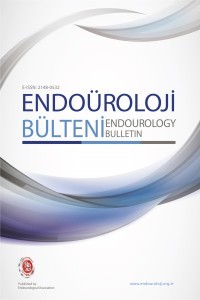Laparoskopik nefrektomide spesmen çıkarma yönteminin hasta memnuniyetine etkisi
Laparoskopi, nefrektomi, ağrı
The effect of specimen extraction site on patient satisfaction in laparoscopic nephrectomy
Laparoscopy, nephrectomy, pain,
___
- 1- Stellato TA. History of laparoscopic surgery. Surg Clin North Am. 1992 Oct;72 (5):997-1002. Laparoscopic general surgery-past, present, and future. Surgery 1993; 113 (1):1-3.
- 2- McDougall EM, Clayman RV. Advances in laparoscopic urology, Part I. History and development of procedures. Urology 1994; 43 (4):420-426. Review.
- 3- Siani LM, Ferranti F, Benedetti M, De Carlo A, Quintaliani A, Laparoscopic versus open radical nephrectomy in T1-T2 renal carcinoma: personal 5-year experience about the oncologic outcome. Minerva Chir 2011; 66:317-321.
- 4- Hemal A.K., et al. Laparoscopic versus open radical nephrectomy for large renal tumors: a long-term prospective comparison. J Urol 2007; 177:862.
- 5- Abbou CC, Cicco A, Gasman D, Hoznek A, Antiphon P, Chopin DK, et al. Retroperitoneal laparoscopic versus open radical nephrectomy. J Urol 1999; 161:1776-1780.
- 6- McDougall EM, Clayman RV. Advances in laparoscopic urology, Part I. History and development of procedures. Urology 1994; 43 (4):420-6. Review.
- 7- Clayman R.V. Kavoussi L.R. Soper N.J. Dierks S.M. Meretyk S. Darcy M.D. Roemer F.D. Pingleton E.D. Thomson P.G. Long S.R. Laparoscopic nephrectomy: initial case report. J.Urol. 1991; 146 (2):278-282.
- 8- El- Galley R: Surgical management of renal tumours. Radiol Clin North Am 2003; 41:1053-1065.
- 9- Taylor GD, and Cadeddu JA: Applications of laparoscopic surgery in urology:impact on patient care. Med Clin North Am 2004; 88:519-538.
- 10- Walther MM, McClellan M, Lyne JC,et al:Laparoscopic cytoreductive nephrectomyas preparation for administration of systemic interleukin-2 in the treatment of metastatic renal cell carcinoma:a pilot study. Urology 1999; 53:496-501.
- 11- Wolf JS, Marcovich R, Merion RM, et al: Prospective, case matched comparison of hand assisted laparoscopic and open surgical live donor nephrectomy. J Urol 2000; 163:1650-1653.
- 12- Ratner LE, Montgomery RA, and Kavoussi LR: Laparoscopic live donor nephrectomy:a review of the first 5 years. Urol Clin North Am 2001; 28:709-719.
- 13- Ono Y, Kinukawa T, Hattori R, et al:Laparoscopic radical nephrectomy for renal cell carcinoma: a five-year experience. Urology 1999; 53:280-286.
- 14- Townsend CM: Sabiston Textbook of surgery, 17th ed. Philadelphia, WB Saunders, 2001, pp 445-464.
- 15- Gill, I.S.: Laparoscopic radical nephrectomy for cancer. Urol. Clin. North America 2000; 27 (4): 707-719.
- 16- Dunn MD, Portis AJ, Shalhav AL, Elnahnasy AM, Heidorn C, McDougall EM, Clayman RV: Laparoscopic versus open radical nephrectomy: A 9 year experience. J. Urol 2000; 1164: 1153-1159.
- 17- Britton Tisdale, Anil Kapoor, Abdullatif Hussain, Kevin Piercey and J Paul Whelan. Intact specimen extraction in laparoscopic nephrectomy procedures: Pfannenstiel versus expanded port site incisions. J Urology 2007; 69:240-244.
- 18- Gill IS, Kerbl K, Meraney AM, et al:Basics of laparoscopic urology surgery, in Walsh PC, Retik AB, Vaughan ED, et al (Eds):Campbell’s Urology, 8 th ed. Philadelphia,WB, Saunders, 2002, pp 3457-3458.
- 19- Depp R:Cesarean delivery, in Gabbe SG, Niebyl, JR, Simpson JL (Eds):Obstetrics: Normal and Problem Pregnancies, 4 th ed. New York, Churchill Livinngstone, 2002, pp 549-550.
- 20- Elashry OM, Giusti G, Nadler RB, et al: Incisional hernia after laparoscopic nephrectomy with intact specimen removal: caveat emptor. J Urol 1997; 158:363-369.
- 21- Whiteside JL, Barber MD, Walters MD, et al:Anatomy of ilioinguinal and iliohipogastric nerves in relation to trocar placement and low transverse incisions. Am J Obstet Gynecol 2007; 189:1574-1578.
- 22- Savage SJ, and Gill IS: İntact specimen extraction during renal laparoscopy: muscle-splitting versus muscle-cutting incision. J Endourology 2001; 61:165-169.
- 23- Camargo AH, Rubenstein JN, Ershoff BD, Meng MV, Kane CJ and Stoller ML: The effect of kidney morcellation on operative time, incision complications, and post operative analgesia after laparoscopic nephrectomy. İnt Braz J Urol 2006; 32:273.
- 24- Troxel SA, Das D. İncisional hernia following hand-assisted laparoscopic surgery for renal cell cancer. JSLS 2005; 9:196.
- 25- A Bbou, CC,Cicco, A,Gamsan: Retroperitoneal laparoscopic versus open redical nephrectomy. J Urol 1999; 161:1776-1780.
- Yayın Aralığı: 3
- Başlangıç: 2020
- Yayıncı: Pera Yayıncılık
Bahadır TOPUZ, Sercan YILMAZ, Serdar YALÇIN, Sanan ASGARLI, Engin KAYA, Murat ZOR, Mesut GÜRDAL, Selahattin BEDİR
Emre KARABAY, Nejdet KARŞIYAKALI, Kemal KAYAR, Levent VERİM, Çağatay TOSUN, Ömer YÜCEBAŞ
Arif AYDIN, Gökhan ECER, Muzaffer KILINÇ, Mehmet BALASAR, Nurullah ALTINKAYA, Hakan TAŞKAPU, Mehmet Giray SÖNMEZ
COVID-19 pandemisi sırasında üriner sistem taş hastalığının yönetimi: tek merkez deneyimi
Gökhan ECER, Mehmet Giray SÖNMEZ, İbrahim GÖKSOY, Mert ARSLANER, Hakan TAŞKAPU, Arif AYDIN, Mehmet BALASAR
Endoskopik Taş Tedavisinde Gelecekte Bizleri Ne Bekliyor?
Fatih SANDIKÇI, Burhan BAYLAN, Abdurrahim İMAMOĞLU
Thulium Lazer ile Prostat Enükleasyonu(ThuLEP) deneyimleri
Eymen GAZEL, Mehmet YILMAZ, Halil Çağrı AYBAL, Engin KAYA, Serdar YALÇIN, Sercan YILMAZ, Onur AÇIKGÖZ, Lütfi TUNÇ
Laparoskopik üreterolitotomi; siz hangi yolu tercih ediyorsunuz?
İlker ŞEÇKİNER, Ali Erdem YILMAZ, Mehmet ÖZTÜRK
Laparoskopik nefrektomide spesmen çıkarma yönteminin hasta memnuniyetine etkisi
Serkan DOĞAN, Bülent ÇELİK, Mehmet YILMAZ
Genç populasyonda mesane tümörlerinin klinik ve patolojik özellikleri
Sercan YILMAZ, Ali YILDIZ, Serdar YALÇIN, Can SİCİMLİ, Ali Fuat ÇİÇEK, Bahadır TOPUZ, Selahattin BEDİR
